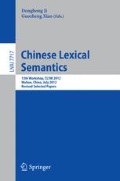Abstract
The objects of VO verbal compounds are realized in a special way. Owing to the lack of Case, they cannot appear in situ, but have to combine with a preposition (so as to get an oblique Case) or appear in the attributives of Os. VO verbal compounds should be distinguished from VO-verbs, which can assign Cases directly to their objects. Besides, affected by prosody, some adverbials of VO-phrases will leave out the prepositions, appearing like objects, and forming another kind of pseudo-VO verbal compounds.
Access this chapter
Tax calculation will be finalised at checkout
Purchases are for personal use only
Preview
Unable to display preview. Download preview PDF.
References
Huang, C.R.: A Unification-Based LFG Analysis of Lexical Discontinuity. Linguistics 28, 263–307 (1990)
Her, O.-S.: Grammatical Representation of Idiom Chunks. In: International Association of Chinese Linguistics 8th Annual Conference, Melbourne, Australia (1999)
Chao, Y.R.: A Grammar of Spoken Chinese. University of California Press, Berkeley (1968)
Li, C.N., Thompson, S.A.: Mandarin Chinese: A Functional Reference Grammar. University of California Press, Berkeley (1981)
Zhu, D.: Lectures on Grammar. The Commercial Press, Beijing (1982) (in Chinese)
Huang, G.: On de: its syntax and semantic function. Studies in Language and Linguistics (1), 101–129 (1982) (in Chinese)
Huang, C.T.J.: Wo Pao De Kuai and Chinese phrase structure. Language 64, 274–311 (1988)
Tang, S.W.: Word Order in Natural Languages and the Theory of Phrase Structure. Contemporary Linguistics 2, 138–154 (2000) (in Chinese)
Feng, S.: The Prosodic Syntax of Chinese. Shanghai Education Press, Shanghai (2000) (in Chinese)
Feng, S.: Prosodically Determined Distinctions between Word and Phrase in Chinese. Studies of The Chinese Language (1), 27–37 (2001) (in Chinese)
Feng, S.: On the Interface between Prosodic Morphology and Prosodic Syntax. Studies of the Chinese Language (6), 515–524 (2002) (in Chinese)
Cai, S.: Semantic Properties and Syntactic Constructing Process of the Specific Dative Construction “V+X+de+O”. Chinese Teaching in the World (3), 363–372 (2010) (in Chinese)
Li, G.: On the Possessive Object Construction “VN de O”. Chinese Language Learning (3), 63–69 (2009) (in Chinese)
Chomsky, N.: Lectures on Government and Binding. Foris, Dordrecht (1981)
Chomsky, N.: Knowledge of language: its nature, origin and use. Praeger, New York (1986)
Ouhalla, J.: Introducing Transformational Grammar: From Principles and Parameters to Minimalism. Edward Arnold, London (1999)
Cui, X.: On kaixin (开心) and guanxin (关心). Studies of The Chinese Language (5), 410–418 (2009) (in Chinese)
Xing, G.: On a kind of sentence pattern that is likely to become popular. Language Planning (4), 21–23 (1997) (in Chinese)
Ling, D.: An Analysis on Verb-object Type+ Object. Chinese Language Learning (5), 9–13 (1999)
Guo, X.: On the Origin and Development of the Preposition yu. Studies of The Chinese Language (2), 131–138 (1997) (in Chinese)
Mei, T.L.: The Source of the Preposition yu in Oracle Bone inscription and in Sino-Tibetan. Studies of The Chinese Language (4), 323–332 (2004) (in Chinese)
Luo, G.: On the Usage of Verb “yu”. Research in Ancient Chinese Language (6), 73–75 (2007) (in Chinese)
Zhang, Y.: On the Origin of “yu”. Chinese Linguistics (4), 16–22 (2009) (in Chinese)
Zhao, Z.: On the Prepositions in Ancient Chinese “yu” (于), “yu” (於) and “hu” (乎). Journal of Sun Yatsen University (4), 98–109 (1964) (in Chinese)
Zhu, X.: An analysis of “yu” in the Shangshu. Journal of Language and Literature Studies (2), 39–42 (1988) (in Chinese)
Shi, B.: On the Origin and Development of Preposition “yu”. Studies of The Chinese Language (4), 343–347 (2003) (in Chinese)
Xuan, J.: Concerning “yu” Used as a Verb in Oracle Bone Inscriptions. Research in Ancient Chinese Language (1), 33–38 (2009) (in Chinese)
Author information
Authors and Affiliations
Editor information
Editors and Affiliations
Rights and permissions
Copyright information
© 2013 Springer-Verlag Berlin Heidelberg
About this paper
Cite this paper
Zhuang, H., Liu, Z., Zhang, Y. (2013). VO Verbal Compounds and the Realization of Their Objects. In: Ji, D., Xiao, G. (eds) Chinese Lexical Semantics. CLSW 2012. Lecture Notes in Computer Science(), vol 7717. Springer, Berlin, Heidelberg. https://doi.org/10.1007/978-3-642-36337-5_28
Download citation
DOI: https://doi.org/10.1007/978-3-642-36337-5_28
Publisher Name: Springer, Berlin, Heidelberg
Print ISBN: 978-3-642-36336-8
Online ISBN: 978-3-642-36337-5
eBook Packages: Computer ScienceComputer Science (R0)

